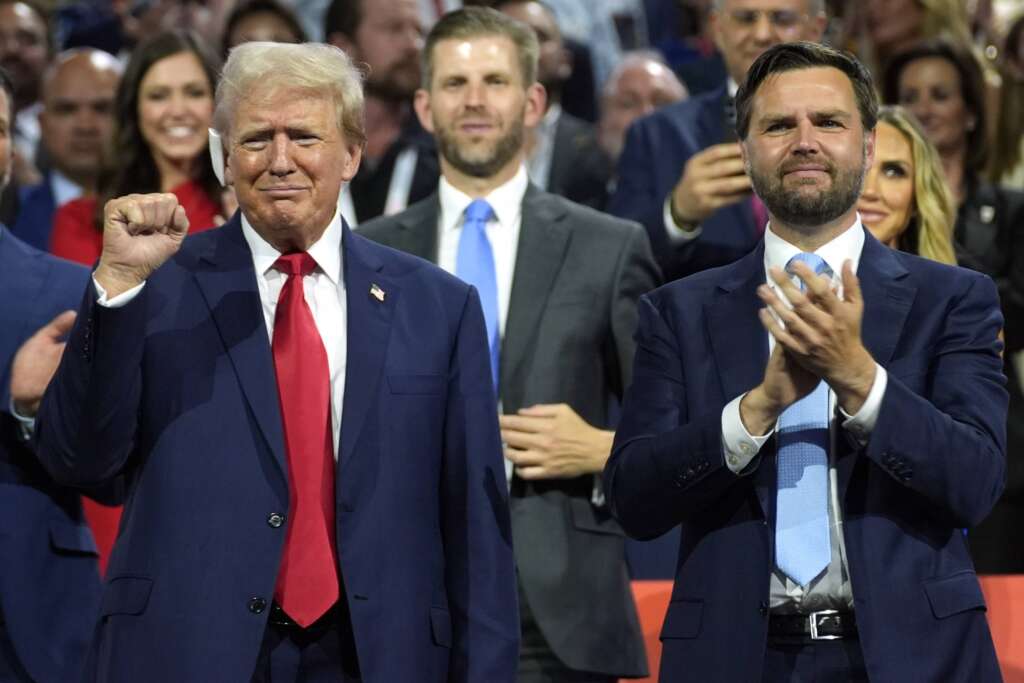
Editor’s Note: In the final days before Election Day, here’s a rundown on where both candidates — and their vice presidents — stand on the issues. Here is what a Harris-Walz administration would mean for federal employees.
Former President Donald Trump, running for a second term, has repeatedly criticized much of the federal workforce, and taken measures to make it easier to fire career federal employees.
Here’s a rundown of how the Trump administration impacted the federal workforce — andd what Trump has vowed to bring back if he is elected for a second term:
Schedule F, Project 2025
As president, Trump signed an executive order that would have reclassified tens of thousands of federal employees in policymaking roles into a new category, called “Schedule F,” making them at-will employees that are easier to fire.
Trump signed the executive order late in his presidency, and didn’t take effect before he left office. President Joe Biden quickly revoked it once stepping into office.
The Office of Personnel Management, under the Biden administration, finalized a rule earlier this year that would make it harder for Trump or any future president to bring Schedule F back into effect.
However, Trump administration officials have been revisiting plans to revive Schedule F, should the presidential election go in their favor
Project 2050, a Heritage Foundation project spearheaded by many former Trump administration officials, outlines the blueprint for a second Trump administration — including the return of Schedule F.
Trump has sought to distance himself from Project 2025. On social media, he said he has not seen the plan and has “no idea who is in charge of it, and, unlike our very well-received Republican Platform, had nothing to do with it.”
It remains unclear how many employees would be impacted by the return of Schedule F. Some estimate that about 50,000 federal employees would become at-will hires under Schedule F.
A 2022 report from the Government Accountability Office showed that although OMB never actually reclassified any positions, approximately 68% of OMB’s workforce would have become at-will.
However, the National Treasury Employee Union, digging up Trump-era OMB documents, said the estimates are, in reality, much higher. NTEU said documents show that OMB was also targeting federal employees in less senior positions, including those in GS-9 and GS-10 roles.
Federal workforce, smaller agency budgets
In a series of videos on his campaign website, Trump said he would put unelected bureaucrats back in their place” in a second term, and outlined his plans to do so.
Trump said he would require every federal employee to pass a new civil service test, “demonstrating an understanding our constitutional, limited government.”
“This will include command of due process rights, equal protection, free speech, religious liberty, federalism, the Fourth Amendment protections against unreasonable search and seizure,” he said.
Trump said his this administration would “squeeze the bloated federal bureaucracy for massive savings.” Agencies, he added, would return funding from their congressionally appropriated budgets that they don’t need.
“On day one, I will order every federal agency to begin identifying large chucks of their budgets that can be saved through efficiencies and waste reduction using impoundment,” he said.
Trump said his administration would not shrink budgets for national security, Medicare or Social Security.
Trump said he would also revoke the Biden administration’s executive order promoting diversity, equity, inclusion and accessibility in the federal workforce.
“Instead of treating everyone equally, making decisions based on merit or qualifications, equity means that benefits are awarded and policies are enforced based on skin color and sexual identity,” Trump said in a March 2023 video on his website. “We don’t think it’s a good idea.”
He said he would also “immediately fire” all staffers hired to implement this policy and eliminate all offices and initiatives connected to it.
To “restore a merit-based federal civil service,” Trump said he would create a special team to “rapidly review every action taken by federal agencies under Biden’s equity agenda that will need to be reversed.”
“When FEMA, the EPA and the FAA and IRS are corrupted and tasked with enforcing equity, freedom and equality under the law are absolutely dead,” Trump said.
Sen. JD Vance (R-Ohio), Trump’s pick for vice president, has largely endorsed his running mate’s platform when it comes to the federal workforce.
Vance, in a 2021 podcast, said that he would give Trump one piece of advice for a second term, it would be to “fire every single midlevel bureaucrat, every civil servant in the administrative state, replace them with our people.”
Endorsements
Most federal unions spent much of the Trump administration in opposition to its policies.
Under his administration, they spent much of their time challenging a trio of executive orders, among other actions, that ultimately challenged their ability to represent their bargaining unit members.
The orders cut official time, limited collective bargaining and removed labor organizations from government office space. Biden rescinded the orders within his first few days in office.
However, the National Border Patrol Council, which represents about 16,000 Border Patrol employees, endorsed Trump earlier this month.
“He has always stood with the men and women who protect this border, who put their lives on the line for the country — a man who knows about putting his life on the line for what is right, Border Patrol Agent Paul Perez, president of the union’s Local 3307, said at a campaign rally in Arizona last month.
Deregulation across agencies
Trump said he would restore his executive order under his first term that required agencies to eliminate two older regulations for every new regulation that would take effect.
Trump said he would also ask Congress to pass legislation to codify the executive order’s provisions into law.
“Instead of growing the size and scope of the federal government every single year —we’ve been doing that — we will shrink it every year with aggressive cost-reduction targets for reach federal department.” he said.
Trump said he would also require agencies to post their regulatory guidance online in a central database, “or else be rendered null and void.”
“This will effectively repeal a mountain of stealth regulations and threats that rogue bureaucrats have opposed without proper oversight,” Trump said.
Trump said he would also bring independent regulatory agencies, such as the Federal Communications Commission and Federal Trade Commission, back under presidential authority.
Trump said these agencies would have to submit their proposed rules to the White House for review.
“These agencies do not get to become a fourth branch of government, issuing rules and edicts all day by themselves, and that’s what they’ve been doing,” Trump said.
Trump said he would also appoint billionaire businessman Elon Musk to lead a government efficiency commission.
Trump, speaking at the Economic Club of New York last month, said the commission would recommend “drastic reforms” and develop a plan to eliminate fraud and improper payments within six months, which he said would save trillions of dollars.
USPS privatization
The Trump administration proposed privatizing the Postal Service as part of the sweeping government reorganization plan. While the idea never moved beyond initial planning, it would have meant significant pay and benefits changes to more than 600,000 USPS employees.
“USPS privatization through an initial public offering (IPO) or sale to another entity would require the implementation of significant reforms prior to sale to show a possible path to profitability,” the 2018 plan stated.
A privatized postal operator, the Trump administration proposed, could cut costs by delivering mail fewer days per week and to more central locations, instead of door-to-door delivery.
“USPS’s current model is unsustainable. Major changes are needed in how the Postal Service is financed and the level of service Americans should expect from their universal service operator,” the reorganization policy stated.
Copyright
© 2024 Federal News Network. All rights reserved. This website is not intended for users located within the European Economic Area.




